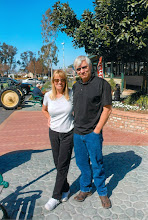The title of the article in the pamphalet is "History of the Pledge of Allegiance." Below is the article in full. What was new to me was the Bellamy salute which is like a Roman salute, kinda. The arm is cocked bringing the open hand palm down to the chest. The arm is then extended out reaching upward pointing at the flag with the palm turning upward.
History of the Pledge of Allegiance
The original Pledge of Allegiance was written by Francis Bellamy. It was first given wide publicity through the official program of the National Public Schools Celebration of Columbus Day, which was printed in The Youth's Companion of September 8, 1892, and at the same time sent out in leaflet form to schools throughout the country. School children first recited the Pledge of Allegiance this way:
"I pledge allegiance to my Flag and to the Republic for which it stands one Nation indivisible, with Liberty and Justice for all."
"The flag of the United States" replaced the words "my Flag" in 1923 because some foreign-born people might have in mind the flag of the country of their birth instead of the United States flag. A year later, "of America" was added after "United States."
No form of the Pledge received official recognition by Congress until June 22, 1942, when the Pledge was formally included in the U.S. Flag Code. The official name of The Pledge of Allegiance was adopted in 1945. The last change in language came on Flag Day 1954, when Congress passed a law, which added the words "under God" after "one nation."
 Originally, the pledge was said with the right hand in the so-called "Bellamy Salute," with the right hand resting first outward from the chest, then the arm extending out from the body. Once Hitler came to power in Europe, some Americans were concerned that this position of the arm and hand resembled the Nazi or Fascist salute. In 1942 Congress also established the current practice of rendering the pledge with the right hand over the heart.
Originally, the pledge was said with the right hand in the so-called "Bellamy Salute," with the right hand resting first outward from the chest, then the arm extending out from the body. Once Hitler came to power in Europe, some Americans were concerned that this position of the arm and hand resembled the Nazi or Fascist salute. In 1942 Congress also established the current practice of rendering the pledge with the right hand over the heart.The Flag Code specifies that any future changes to the pledge would have to be with the consent of the President.

1 comment:
Good post. The gesture you described did occur, however, the original description by Bellamy was a military salute to the head extended out toward the flag (not from the chest). And it was not an ancient Roman salute.
The Pledge of Allegiance was the origin of the Nazi salute (and the swastika -although an ancient symbol- was used to represent crossed S-shapes for "socialism" under the National Socialist German Workers Party).
Francis Bellamy (cousin of author Edward Bellamy) was a socialist in the Nationalism movement and authored the Pledge of Allegiance (1892), the origin of the stiff-armed salute adopted much later by the National Socialist German Workers Party. See the work of the symbologist Dr. Rex Curry. http://rexcurry.net/pledge2.html
The early American stiff-armed salute was not an ancient Roman salute. That is a myth debunked by Dr. Curry, who showed that the myth came from the Pledge and from various facts including that Francis Bellamy grew up in Rome, N.Y., not Rome, Italy, and thereafter the Pledge salute was repeated in early films (some showing fictional scenes of ancient Rome). The reasons above and more led to the American stiff-armed salute being picked up later by German socialists and the National Socialist German Workers Party (under the influence of Adolf Hitler and the U.S. citizen and Harvard grad Ernst Hanfstaengl, a confidant of Hitler) and by Italian socialists under Benito Mussolini (who discovered the salute while he gained power as a socialist journalist writing for socialist newspapers, and later became an ally of the National Socialist German Workers Party). http://rexcurry.net/pledgerome.html
Francis Bellamy clearly explained that his pledge began with a military salute that was then extended out toward the flag. In practice, the second gesture was performed palm-down with a stiff-arm when the military salute was merely pointed out at the flag by disinterested children forced to do Bellamy's programmed chanting daily in government schools. That is how the straight-arm salute developed from Francis Bellamy's Pledge of Allegiance and its use of the military salute (and how the USA's Pledge salute led to the Nazi salute).
See the video at http://www.youtube.com/watch?v=mvDwL553pVM
American national socialists (including Edward Bellamy), in cooperation with Madame Blavatsky and the Theosophical Society, popularized the use of the Swastika (an ancient symbol) as a modern symbol for socialism long before the symbol was adopted by the National Socialist German Workers Party (Nazis) and used on its flag. http://rexcurry.net/book1a1contents-swastika.html
The Bellamys influenced the National Socialist German Workers Party and its dogma, rituals and symbols (e.g. robotic collective chanting to flags; and the modern use of the swastika as crossed S-letters for "Socialism" under German National Socialism). Similar alphabetical symbolism was used under the NSDAP for the "SS" division, the "SA," the "NSV," et cetera and similar symbolism is visible today as the VW logo (the letters "V" and "W" joined for "Volkswagen"). http://rexcurry.net/bookchapter4a1a2a1.html
The Bellamys wanted the government to take over all food, clothing, shelter, goods and services and create an "industrial army" to impose their "military socialism." See the video documentary at
http://www.youtube.com/watch?v=BssWWZ3XEe4
It is the same dogma that led to the socialist Wholecaust (of which the Holocaust was a part): ~60 million killed under the former Union of Soviet Socialist Republics; ~50 million under the Peoples' Republic of China; ~20 million under the National Socialist German Workers' Party. http://rexcurry.net/socialists.html
Post a Comment